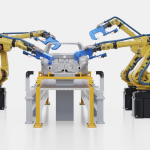Once confined to pilot projects, narrow AI is now driving real-world gains across supply chains, from sharper demand planning to faster, leaner warehouse execution. Unlike generative AI, it excels at solving specific, rules-based problems using operational data. Companies from BMW to Nestlé are applying it to reduce downtime, improve forecasting, and streamline execution. As the technology matures, its role is shifting from pilot experiments to core infrastructure.
Narrow AI Outperforms GenAI
At its core, narrow AI is built for specificity. It thrives on structured tasks with defined boundaries, making it a natural fit for the operational rigor of supply chain environments. Unlike generative AI, which is designed to reason across abstract prompts, narrow AI works within tight parameters to continuously improve task performance.
BMW’s Regensburg plant, for example, saves over 500 minutes of downtime per year by using predictive maintenance models grounded in narrow AI. These models don’t “imagine” possible faults, they detect patterns in telemetry data that correlate with failure events. The same principle is transforming planning processes. Narrow AI systems are helping manufacturers like Nestlé forecast cocoa yields by linking historical crop data with weather variability, improving both production stability and sustainability.
Where historical mismatches once derailed forecasting models, narrow AI is now providing planners with sharper confidence intervals in capacity and material planning. Its rule-bound structure allows for clearer accountability, enabling companies to adjust faster when conditions change.
Execution Gains: From Warehouse Flow to the Final Mile
Narrow AI’s impact is even more tangible in execution. In warehouse environments, it works alongside WMS platforms to guide AMRs, optimize pick paths, and reassign labor with minimal downtime. Unlike broader AI models, which might recommend overly abstract changes, narrow AI delivers precise adjustments based on real-time operational data.
In last-mile logistics, route optimization tools powered by narrow AI are reducing fuel usage and improving delivery speed by layering historical delivery performance with live inputs like weather and traffic. However, some logistics firms are intentionally combining these tools with driver feedback loops, recognizing that algorithms still can’t fully capture the nuance of local delivery knowledge.
Narrow AI also has a growing role in robotics task orchestration. Companies deploying collaborative robots (cobots) are using narrow AI to assign micro-tasks based on real-time load balancing, pick zone congestion, and performance patterns, all without relying on generative inference. The results are higher throughput and reduced idle time across fulfillment networks.
Data Quality Is the Differentiator
The effectiveness of narrow AI isn’t about the sophistication of its code, it’s about the cleanliness and consistency of its input data. Companies making real gains are those that have built data pipelines around operational specificity: clean pick path records, structured capacity models, SKU-level yield data.
To operationalize narrow AI, supply chain organizations are investing in automated data governance frameworks:
- Real-time integration across planning, inventory, and logistics platforms
- Granular, rule-based data shaping for task-specific insights
- Continuous validation and cleansing routines to avoid model drift
These efforts turn narrow AI from a one-off optimization tool into a repeatable performance lever.
When Precision Becomes a Liability
The strength of narrow AI lies in its ability to optimize for known variables, but that precision can become a vulnerability when conditions change abruptly. As models fine-tune operations around historical patterns, they risk locking in assumptions that no longer hold. To stay resilient, organizations must treat AI outputs as inputs for judgment, not replacements for it, building space for human oversight and adaptive thinking alongside algorithmic efficiency.





